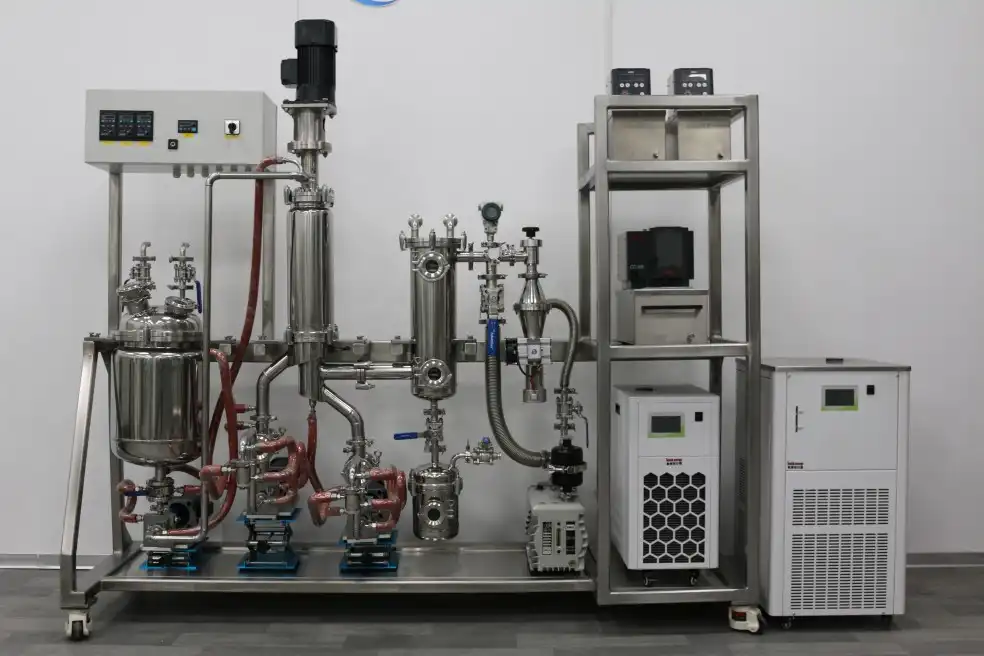Molecular Distillation Equipment: What You Need to Know
Are you struggling with heat-sensitive compounds degradation during traditional distillation? Stainless Steel Molecular Distillation offers a breakthrough solution for purifying high-value materials without thermal damage. This comprehensive guide reveals everything you need to know about selecting, operating, and optimizing molecular distillation equipment for pharmaceutical, food, and chemical applications.
Molecular distillation represents a paradigm shift from conventional separation methods. Unlike traditional distillation that relies on boiling point differences, Stainless Steel Molecular Distillation exploits the variance in molecular mean free paths between different substances. This fundamental principle enables separation at extremely low temperatures and high vacuum conditions, typically operating at pressures below 0.1 Pa. The technology has revolutionized industries dealing with thermally unstable compounds, where conventional methods cause molecular degradation, oxidation, or polymerization. Modern stainless steel construction ensures superior corrosion resistance and maintains product purity, making it indispensable for pharmaceutical-grade separations and high-value natural product purifications.
The Science Behind Molecular Distillation Systems
The separation mechanism in Stainless Steel Molecular Distillation depends on molecular kinetics rather than vapor-liquid equilibrium. When molecules evaporate from a heated surface, lighter molecules with longer mean free paths travel further before collision, reaching a nearby condenser surface. Heavier molecules with shorter mean free paths fail to reach the condenser and return to the liquid phase. This selective transport occurs across distances comparable to molecular mean free paths, typically measured in millimeters. The ultra-high vacuum environment minimizes intermolecular collisions, allowing efficient separation without requiring high temperatures. This gentle process preserves delicate molecular structures in essential oils, vitamins, and bioactive compounds that would otherwise decompose under conventional distillation conditions.
Key Components of Industrial Molecular Distillation Units
Professional Stainless Steel Molecular Distillation systems integrate several critical components for optimal performance. The evaporating surface, constructed from 316 stainless steel, provides excellent heat transfer while resisting chemical attack from aggressive solvents and acids. Wiping mechanisms using PTFE or graphite blades continuously spread thin liquid films across the heated surface, maximizing evaporation rates while preventing thermal degradation. Condensers positioned just millimeters from the evaporator capture distillate molecules immediately upon evaporation. Advanced vacuum systems incorporating liquid nitrogen cold traps achieve ultra-high vacuum levels, protecting mechanical pumps from solvent vapors while improving separation efficiency. Control systems featuring ABB frequency converters and UL-listed electrical components ensure precise temperature, pressure, and flow rate management throughout multi-stage separation processes.
Essential Factors When Selecting Stainless Steel Molecular Distillation Equipment
Choosing appropriate molecular distillation equipment requires careful evaluation of multiple technical specifications and operational requirements. Equipment capacity must match production scale, with laboratory units starting at 0.1 square meters and industrial systems exceeding 10 square meters of evaporating area. Vacuum capability directly impacts separation quality, with premium Stainless Steel Molecular Distillation systems achieving 0.1 Pa operating pressure through magnetic sealing and ceramic bearings that eliminate contamination from traditional lubrication. Material compatibility ensures 316 stainless steel construction resists corrosive feedstocks encountered in pharmaceutical synthesis and natural product extraction. Multi-stage configurations enable sequential purification steps, improving final product purity while recovering valuable intermediate fractions. Certification requirements vary by application, with CE, ISO, UL, and SGS approvals demonstrating compliance with international safety and quality standards.
Single-Stage Versus Multi-Stage Distillation Configurations
Single-stage Stainless Steel Molecular Distillation systems provide cost-effective solutions for applications requiring moderate purity improvements or straightforward light-heavy component separations. These units excel at removing residual solvents, decolorizing crude extracts, or eliminating low-boiling impurities from natural products. Multi-stage configurations dramatically expand separation capabilities by performing sequential distillations on progressively purified fractions. In fish oil processing, four-stage systems achieve 80% combined EPA and DHA content from crude ethyl esters through careful fraction cutting between stages. Squalene purification reaches 98% purity through multi-stage processing that removes fatty acids, esters, and other impurities while recovering valuable solvent streams. Industrial lubricating oil regeneration employs three-stage cascades to produce multiple base oil grades with distinct viscosity characteristics from waste feedstocks.
Critical Performance Specifications and Quality Indicators
Operating vacuum level fundamentally determines separation capability in Stainless Steel Molecular Distillation systems. Systems achieving 0.1 Pa enable processing of extremely high-boiling compounds without thermal decomposition, essential for specialty chemicals and pharmaceutical intermediates. Evaporating surface temperature control within ±2°C ensures consistent product quality and prevents hot spots that cause localized degradation. Wiper blade design and rotation speed affect film thickness and residence time, with optimized geometries maximizing throughput while maintaining separation efficiency. Condensing surface area and cooling capacity must match evaporation rates to prevent vapor breakthrough and product loss. Material specifications extend beyond vessel construction to include SKF ceramic bearings, magnetic rotary seals, and KingLai vacuum valves that collectively ensure reliable operation and minimal maintenance requirements over extended production campaigns.
Industrial Applications of Stainless Steel Molecular Distillation
Pharmaceutical manufacturing extensively employs Stainless Steel Molecular Distillation for purifying sensitive active ingredients and excipients. Polyethylene glycol synthesis using microchannel reactors produces narrow molecular weight distributions, with molecular distillation removing residual catalysts and unreacted monomers while preserving polymer integrity. Squalene purification from plant sources achieves pharmaceutical-grade purity through multi-stage distillation that eliminates fatty acids and ester impurities without chemical treatments. Traditional distillation degrades these bioactive compounds through oxidation and thermal stress, making molecular distillation the preferred technology for maintaining biological activity and therapeutic efficacy.
Food Industry Purification and Enrichment Processes
Fish oil processing demonstrates the transformative impact of Stainless Steel Molecular Distillation on natural product industries. Traditional separation methods recover only 16% of valuable omega-3 fatty acids with poor organoleptic properties and high peroxide values indicating oxidation damage. Molecular distillation increases recovery to 70% while producing light-colored products with minimal fishy odor and low peroxide values. The process separates EPA and DHA ethyl esters from saturated and monounsaturated fatty acids based on subtle differences in molecular mean free paths. Four-stage configurations enable flexible EPA:DHA ratio targeting for specific nutritional applications. Tea oil deacidification using molecular distillation removes free fatty acids without alkaline refining, preserving antioxidants and bioactive compounds while eliminating waste generation from neutralization and washing steps.
Specialty Chemical and Essential Oil Processing
Rose essential oil purification illustrates Stainless Steel Molecular Distillation's value for high-value natural products. Supercritical CO2 extraction produces crude oil containing waxes, color bodies, and odor-causing impurities that compromise product quality and market value. Molecular distillation refines this material without the molecular rearrangement, oxidation, or solvent residues associated with traditional dewaxing methods. The gentle separation preserves delicate fragrance notes and therapeutic properties while removing impurities that cause turbidity and off-odors. Plant oil purification for cosmetic applications achieves residual solvent levels below 10 ppm through integrated thin film evaporation and molecular distillation, meeting stringent regulatory requirements for personal care products. Lanolin fractionation produces specialized derivatives including polyoxyethylene lanolin and acetyllanolin through sequential distillation and chemical modification of separated components.
Operational Excellence and Maintenance Best Practices
Successful Stainless Steel Molecular Distillation operation demands rigorous attention to process parameters and equipment conditioning. System preparation begins with thorough cleaning using appropriate solvents, followed by vacuum testing to confirm seal integrity and identify potential leaks. Cold trap conditioning with liquid nitrogen establishes ultra-high vacuum before introducing feedstock, protecting mechanical pumps from solvent vapors while improving ultimate vacuum levels. Feed rate optimization balances throughput against separation efficiency, with excessive rates overwhelming evaporating capacity and reducing product purity. Temperature management requires careful coordination between evaporating and condensing surfaces to maximize driving force while preventing thermal degradation of sensitive components.
Troubleshooting Common Processing Challenges
Inadequate vacuum levels typically result from seal deterioration, contaminated diffusion pumps, or insufficient cold trap capacity. Magnetic sealing technology in premium Stainless Steel Molecular Distillation systems eliminates dynamic seal wear while simplifying maintenance compared to traditional mechanical seals. Ceramic bearings operating without lubrication prevent oil contamination that degrades vacuum and contaminates products. Poor separation efficiency may indicate improper temperature settings, excessive feed rates, or inadequate wiper blade contact with evaporating surfaces. PTFE and graphite blade materials resist chemical attack while maintaining consistent film spreading over extended campaigns. Product discoloration suggests thermal decomposition from localized overheating or prolonged residence times, requiring temperature reduction or feed rate increases to minimize thermal stress.
Quality Assurance and Validation Protocols
Comprehensive quality control ensures Stainless Steel Molecular Distillation systems meet stringent performance specifications. Vacuum qualification verifies system achieves rated pressure levels under typical operating conditions, with acceptance criteria typically requiring pressures below 0.5 Pa for pharmaceutical applications. Temperature mapping confirms uniform heating across evaporating surfaces and identifies potential hot spots requiring adjustment. Product purity analysis using gas chromatography, mass spectrometry, or spectroscopic methods validates separation efficiency and confirms absence of decomposition products. Process validation establishes reproducibility through multiple production runs, documenting critical parameters and acceptable ranges for routine manufacturing. Equipment qualification following GAMP guidelines demonstrates suitability for pharmaceutical manufacturing, with installation qualification, operational qualification, and performance qualification documentation satisfying regulatory requirements.
Conclusion
Stainless Steel Molecular Distillation represents essential technology for purifying thermally sensitive, high-value compounds across pharmaceutical, food, and specialty chemical industries. Understanding equipment specifications, operational principles, and application requirements enables informed equipment selection and process optimization for maximum productivity and product quality.
Cooperate with Xi'an Well One Chemical Technology Co., Ltd
Since 2006, Xi'an Well One Chemical Technology Co., Ltd has specialized in synthesis and purification separation equipment, delivering molecular distillation devices from laboratory to industrial scale. With 1500 m² offices, 500 m² R&D laboratories, and 4500 m² manufacturing facilities, the company provides comprehensive process development, equipment design, testing, and pilot services. As a leading China Stainless Steel Molecular Distillation factory, China Stainless Steel Molecular Distillation supplier, and China Stainless Steel Molecular Distillation manufacturer, Well One offers China Stainless Steel Molecular Distillation wholesale with competitive Stainless Steel Molecular Distillation price. Premium Quality Stainless Steel Molecular Distillation features 316 stainless steel construction, UL-listed electrical components, ABB control systems, and CE, ISO, UL, SGS certifications. OEM & ODM customization with 3D animation, comprehensive R&D through after-sales support, and one-year warranty ensure customer success. High Quality Stainless Steel Molecular Distillation for sale serves pharmaceutical, food, petrochemical, and fine chemical industries worldwide. Contact info@welloneupe.com today to discuss your purification requirements and receive customized solutions from experienced process engineers.
References
1. "Molecular Distillation: Principles and Applications" by Batistella CB and Maciel MRW, Brazilian Journal of Chemical Engineering
2. "Short Path Distillation Technology in Industrial Applications" by Kapil A, Bhat SA, and Bhat RA, Industrial & Engineering Chemistry Research
3. "Vacuum Distillation of Thermally Sensitive Compounds" by Perry RH and Green DW, Perry's Chemical Engineers' Handbook
4. "Advanced Separation Processes for Essential Oils and Natural Products" by Reverchon E and De Marco I, Journal of Supercritical Fluids




